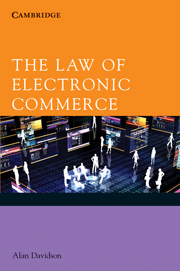Book contents
- Frontmatter
- Contents
- Acknowledgements
- Table of Cases
- Table of statutes
- 1 The law of electronic commerce
- 2 The rule of cyberspace
- 3 Electronic commerce and the law of contract
- 4 Shrinkwrap, clickwrap and browsewrap contracts
- 5 Electronic signatures
- 6 Copyright issues in electronic commerce
- 7 Electronic commerce – trade marks, patents and circuit layouts
- 8 Domain names
- 9 Domain name disputes
- 10 Uniform domain name dispute resolution policies
- 11 Jurisdiction in cyberspace
- 12 Defamation in cyberspace
- 13 Privacy and data protection in cyberspace
- 14 Electronic mail and online presence
- 15 National electronic surveillance
- 16 Cybercrime
- 17 Evidence of electronic records
- 18 Censorship – Broadcast and online content regulation
- 19 An international perspective
- Appendix A Electronic Transactions (Victoria) Act 2000
- Appendix B UNCITRAL Model Law on Electronic Commerce
- Appendix C Selected provisions Copyright Act 1968 (Cth)
- Appendix D ICANN Uniform Dispute Resolution Policy (UDRP)
- Appendix E .au Dispute Resolution Policy (auDRP)
- Appendix F National Privacy Principles
- Index
- References
5 - Electronic signatures
Published online by Cambridge University Press: 05 June 2012
- Frontmatter
- Contents
- Acknowledgements
- Table of Cases
- Table of statutes
- 1 The law of electronic commerce
- 2 The rule of cyberspace
- 3 Electronic commerce and the law of contract
- 4 Shrinkwrap, clickwrap and browsewrap contracts
- 5 Electronic signatures
- 6 Copyright issues in electronic commerce
- 7 Electronic commerce – trade marks, patents and circuit layouts
- 8 Domain names
- 9 Domain name disputes
- 10 Uniform domain name dispute resolution policies
- 11 Jurisdiction in cyberspace
- 12 Defamation in cyberspace
- 13 Privacy and data protection in cyberspace
- 14 Electronic mail and online presence
- 15 National electronic surveillance
- 16 Cybercrime
- 17 Evidence of electronic records
- 18 Censorship – Broadcast and online content regulation
- 19 An international perspective
- Appendix A Electronic Transactions (Victoria) Act 2000
- Appendix B UNCITRAL Model Law on Electronic Commerce
- Appendix C Selected provisions Copyright Act 1968 (Cth)
- Appendix D ICANN Uniform Dispute Resolution Policy (UDRP)
- Appendix E .au Dispute Resolution Policy (auDRP)
- Appendix F National Privacy Principles
- Index
- References
Summary
The signature has been the prime method a person uses as a proof of identity, and as a material expression of intent and execution of documents. A signature on a document indicates the provenance of the document and the intention of the signatory with regard to that document. With the advent of the electronic era, a form of signature is adopted for electronic documents. This chapter examines the regulation, use and security of electronic signatures and the types of electronic signatures, such as digital signatures and SSL technology, being used in electronic commerce.
Traditional signatures
Understanding an electronic signature involves understanding the purpose and use of the traditional signature. The status of traditional signatures has been taken for granted or assumed. The law has developed for centuries with notions of deeds and documents being signed, sealed and delivered, witnessed, notarised and so forth. In some situations a signatory is bound on signing, and in others the signatory is not bound until there is an affirming act. The underlying intention of the signatory may be to be bound only by the subsequent act of delivery. There may be many signatures on a contract: one person may sign intending to be bound by the terms of the contract, while another is merely a witness, with no legal interest in the terms. Their intention is paramount.
- Type
- Chapter
- Information
- The Law of Electronic Commerce , pp. 74 - 88Publisher: Cambridge University PressPrint publication year: 2009



